文章信息
- 杨盛, 郝国伟, 张晓伟, 白牡丹, 李凯, 石美娟, 程培红, 郭黄萍, 李六林
- Yang Sheng, Hao Guowei, Zhang Xiaowei, Bai Mudan, Li Kai, Shi Meijuan, Cheng Peihong, Guo Huangping, Li Liulin
- ‘玉露香梨’僵芽发生与矿质营养的关系
- Effects of Mineral Nutrition on Formation of Wizened Bud in ‘Yuluxiangli’ Pear
- 林业科学, 2016, 52(2): 127-133
- Scientia Silvae Sinicae, 2016, 52(2): 127-133.
- DOI: 10.11707/j.1001-7488.20160216
-
文章历史
- 收稿日期:2014-11-26
- 修回日期:2015-09-06
-
作者相关文章
2. 山西农业大学园艺学院 太谷 030801
2. College of Horticulture, Shanxi Agricultural University Taigu 030801
在部分梨(Pyrus)树栽培地区发现部分梨品种存在僵芽现象,如丰水、雪花梨、红香酥和玉露香梨等。严重时花量极少,几乎绝收,给梨农带来了巨大损失。以往关于果树僵芽的报道多集中在桃(Amygdalus)树上,张志存等(1998)认为,春季气温升高时花芽很快萌动,抗寒力降低,致使低温来临时失去抵抗能力而形成僵芽。笔者课题组从2009年开始在梨僵芽发生严重的河北深泽、深州、赵县、魏县以及北京大兴等地梨园开展了僵芽发生期调查,发现8月就出现芽体松软、爆裂和褐化现象,在解剖镜下观察花序,芽体较正常的小而且已完全褐化。因此,梨僵芽在花芽分化当年就已发生,并非冻害所致。
矿质元素在果树生理中具有重要作用,树体内的矿质元素不仅影响营养生长,而且严重影响花芽分化和果实的生长(Goldschmidt,1997)。目前有关营养对花芽分化的研究主要集中在氮和碳水化合物上,研究认为,大量施用氮肥,能阻止苹果(Malus pumila)花芽分化,旺盛的蛋白质代谢不利于花芽分化(Titus,1960;彭芳等,2012),碳水化合物是启动果树成花的重要因素之一(Greeenberg et al., 1992;邢利博,2013)。关于果树矿质元素的变化规律及其对果树影响的研究,大多集中在叶片中矿质元素的变化规律方面(甑芳等,2010;宗宇等,2011;贾兵等,2011;李广会等,2012),而有关梨僵芽的研究很少。本研以河北魏县僵芽发生梨园(以下简称魏县僵芽梨园)、河北魏县经栽培措施处理后花芽发育正常梨园(以下简称: 魏县正常梨园)和山西太谷花芽正常形成梨园(以下简称: 太谷正常梨园)的‘玉露香梨’为试材,通过测定花芽分化期短枝花芽及其相邻叶片中的矿质元素含量并分析其动态变化,研究矿质元素对花芽分化的影响,探索僵芽发生的生理机制,为预防梨僵芽的发生提供理论依据。
1 材料与方法 1.1 试验材料本试验于2012—2014年在河北省魏县僵芽梨园、魏县正常梨园和山西省农业科学院果树研究所梨示范园内进行。魏县梨园(36°03′ N,114°43′ E),极端最高温41.1 ℃,极端最低温-19.8 ℃,年均气温 10.5 ℃,>10 ℃年积温4 416 ℃,无霜期240天,年平均降雨量526 mm左右,主要集中在6—8月,约占年降雨量的62.8%,海拔45.5~58.5 m。山西太谷梨园(37°26′ N,112°32′ E),年均气温 9.8 ℃,>10 ℃年积温3 529 ℃,无霜期149天,年平均降雨量450 mm左右,蒸发量为降水量的4倍,约1 800 mm,海拔750 m。3个梨园的砧木都为杜梨(P. betulaefolia),树龄15年,魏县僵芽梨园和魏县正常梨园相邻。
1.2 试验设计于花芽形态分化期(6月初—8月中旬),分别在魏县未经栽培措施处理的僵芽发生梨园,魏县经控肥、控水、覆盖地膜、喷施生长延缓剂、拉枝、环割等栽培措施处理的花芽发育正常梨园和太谷花芽正常分化的梨园各选择6株树势和负载量相对一致的试验树,每5天随机从树体不同方位选取短枝花芽30个,保存于FAA固定液中,用于花芽分化期观察;每15天随机从树体不同方位选取短枝花芽100个及相邻叶片100片,带回实验室后处理干净,于105 ℃杀酶20 min,80 ℃烘干,粉碎,自封袋干燥保存,用于矿质元素测定。
1.3 试验方法运用石蜡切片改良法对‘玉露香梨’花芽分化进程进行观察。样品处理采用干灰化-稀盐酸溶解法,测定采用火焰原子吸收法(鲁如坤,1999)。
1.4 统计分析采用Excel软件和SAS统计软件进行分析和作图。
2 结果与分析 2.1 不同梨园营养生长与僵芽发生由表 1可知,魏县、太谷正常梨园中1年生新梢(长度)年生长量分别为魏县僵芽梨园的72.5%和53.6%,新梢直径生长量分别为魏县僵芽梨园的74.1%和72.3%。魏县僵芽梨园停长时间为9月初,晚于魏县、太谷正常梨园。
|
|
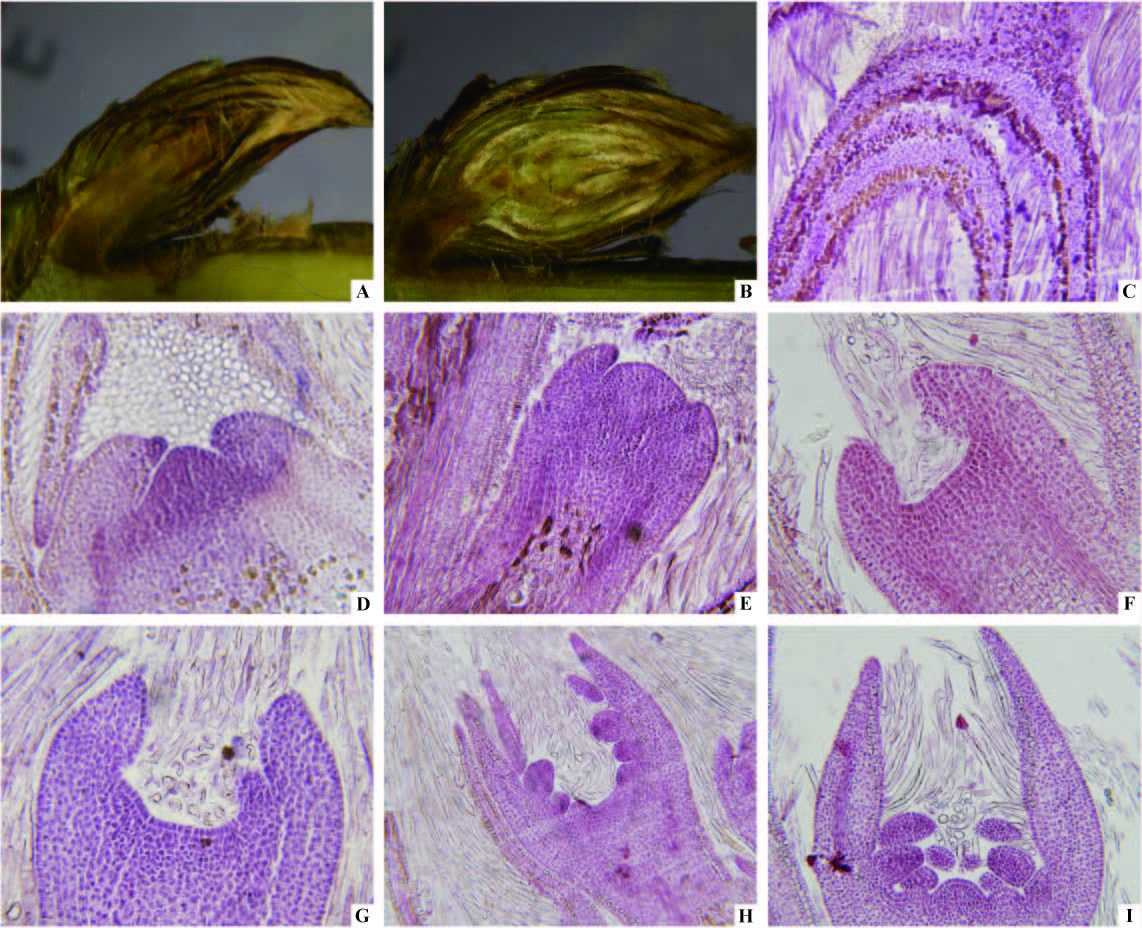
|
图1
‘玉露香梨’花芽形态分化进程
Fig.1
Bud morphological differentiation of ‘Yuluxiangli’ pear
A: 僵芽,×10;B: 正常花芽,×10;C: 未分化期,×100;D: 分化初期,×100;E: 花蕾分化期,×200;F: 花萼分化期,×200;G: 花瓣分化期,×200;H: 雄蕊分化期,×200;I: 雌蕊分化期,×100。 A: Abnormal bud differentiation with wizened bud,×10; B: Normal bud differentiation,×10;C: Undifferentiation phase,×100; D: Initial differentiation phase,×100; E: flower bud differentiation phase,×200; F: Sepal differentiation phase,×200; G: Petal differentiation phase,×200; H: Stamen differentiation phase,×200; I: pistil differentiation phase,×100 |
显微结构观察,出现僵芽的花芽组织褐化死亡(图 1A),正常花芽饱满(图 1B)。正常花芽形态分化进程中,6月初以前处于未分化期,此时期生长点狭小、光滑,纵切面呈圆锥状(图 1C);6月初至6月中旬为分化初期,此时生长点增大变圆,为一扁平的半球体(图 1D);6月中旬至7月初为花蕾分化期,其标志为肥大隆起的生长点变得不圆滑,并出现突起形状(图 1E);7月初至7月中旬为花萼分化期,花原基顶部变平坦,中间部分相对凹入,而四周产生突起体(图 1F),为花萼原始体;7月中下旬为花瓣分化期,萼片内侧基部发生突起体(图 1G),即花瓣原始体;7月下旬至8月中上旬为雄蕊分化期,花瓣原始体内侧基部发生突起(图 1H)即雄蕊原始体;8月中旬至9月上旬为雌蕊分化期,在花原始体中心底部发生突起即雌蕊,雌蕊基部的子房深埋于花托组织中(图 1I)。需要说明的是,僵芽形态分化进程中未分化期、分化初期、花蕾分化期切片与正常花芽一致,花萼分化期由于部分组织枯萎,无法进行正常切片,推断僵芽始于花萼分化期。
2.3 不同梨园芽及叶片中矿质元素变化1)不同梨园芽及叶片中大量元素变化不同梨园花芽中K含量先减少后增加,7月15日(花萼分化期)含量最低,之后缓慢上升。在整个花芽分化期,魏县僵芽梨园花芽中K含量显著低于魏县正常梨园和太谷正常梨园,且太谷正常梨园花芽中K含量最高。短枝花芽附近叶片中K含量总体呈下降趋势,魏县僵芽梨园僵芽发生前的6月16日和7月1日K含量显著高于正常梨园(图 2)。
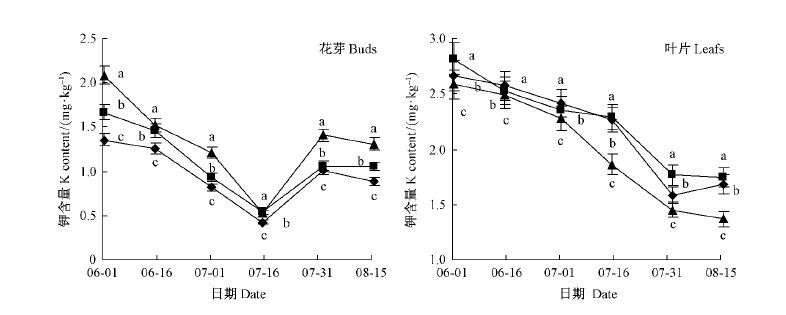
|
图2 ‘玉露香梨’发育期间花芽和叶内K含量变化 Fig.2 K content changes of flower bud and leaf during the whole developmental stages —◆— 魏县僵芽梨园The wizened bud pear orchard in Weixian;—■— 魏县正常梨园 The abnormal pear orchard in Weixian;—▲— 太谷正常梨园The abnormal pear orchard in Taigu. 不同字母表示相同时间在 α=0.05 水平上有显著性差异。下同。Values with the different letters have significant differences at α=0.05 level at the same period. The same below. |
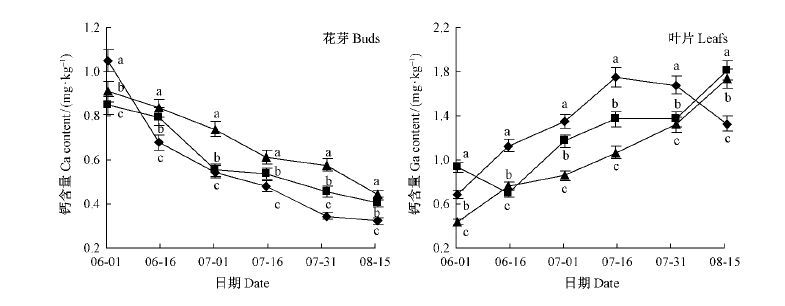
|
图3 ‘玉露香梨’发育期间花芽和叶内Ca含量变化 Fig.3 Ca content changes of flower bud and leaf during the whole developmental stages |
不同梨园花芽中Ca含量呈下降趋势,而短枝花芽附近叶片中Ca含量总体呈现增加趋势。6月16日—8月15日,魏县僵芽梨园花芽中Ca含量显著低于魏县正常梨园和太谷正常梨园;而6月16日—7月31日短枝花芽附近叶片中Ca含量显著高于魏县正常梨园和太谷正常梨园(图 3)。
不同梨园花芽中Mg含量在6月中旬处于低谷,7月中旬处于最大值。7月1日以后,魏县僵芽梨园花芽中Mg含量显著低于魏县正常梨园和太谷正常梨园。6月16日—7月16日,短枝花芽附近叶片中Mg含量缓慢上升,之后略有回落,且魏县僵芽梨园在6月16日—7月31日显著高于魏县正常梨园和太谷正常梨园(图 4)。
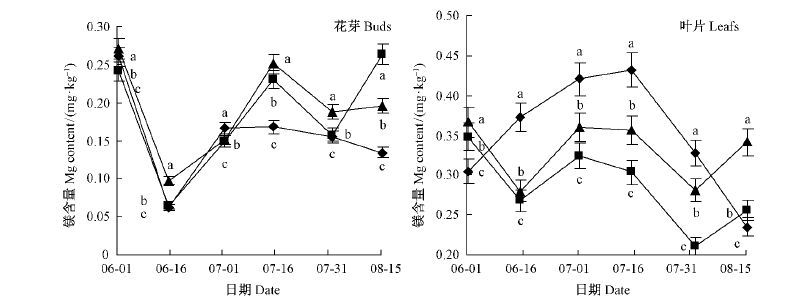
|
图4 ‘玉露香梨’发育期间花芽和叶内Mg含量变化 Fig.4 Mg centent changes of flower bud and leaf during the whole developmental stages |
2)不同梨园芽及叶片中微量元素变化不同梨园花芽k Fe含量变化趋势基本一致,均在7月中旬有一1高峰,6月中旬和8月初有2个低值。整个花芽分化期,魏县僵芽梨园花芽中Fe含量始终高于魏县正常梨园和太谷正常梨园。短枝花芽附近叶片中Fe含量变化趋势基本一致,魏县僵芽梨园在僵芽发生后显著高于正常梨园(图 5)。
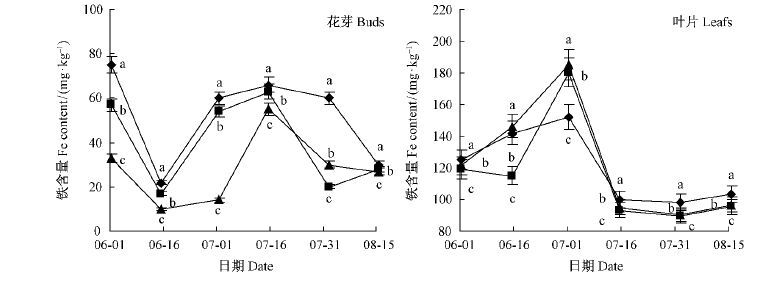
|
图5 ‘玉露香梨’发育期间花芽和叶内Fe含量变化 Fig.5 Fe content changes of flower bud and leaf during the whole developmental stages |
不同梨园花芽中Mn含量呈先下降后上升再下降的趋势,在6月16日都有低谷,魏县正常梨园和太谷正常梨园在7月31日均达到高峰,而魏县僵芽梨园在7月16日达到高峰。7月16日之后,魏县僵芽梨园花芽中Mn含量显著低于魏县正常梨园和太谷正常梨园。在短枝花芽附近叶片中,不同梨园的Mn含量呈缓慢上升趋势,且在整个分化期,魏县僵芽梨园始终低于魏县正常梨园和太谷正常梨园(图 6)。
不同梨园花芽中Zn含量变化趋势一致,但波动较大。6月16日以后,魏县僵芽梨园花芽中Zn含量显著低于魏县正常梨园和太谷正常梨园。在整个花芽分化期,魏县僵芽梨园短枝花芽附近叶片中的Zn含量始终低于魏县正常梨园和太谷正常梨园。6月16日—7月31日,短枝花芽附近叶片中Zn含量基本呈上升趋势(图 7)。
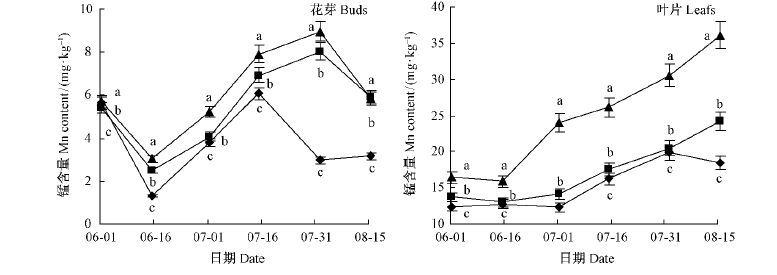
|
图6 ‘玉露香梨’发育期间花芽和叶内Mn含量变化 Fig.6 Mn content changes of flower bud and leaf during the whole developmental stages |
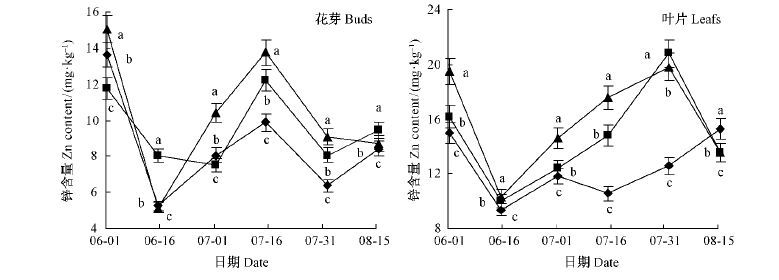
|
图7 ‘玉露香梨’发育期间花芽和叶内Zn含量变化 Fig.7 Zn content changes of flower bud and leaf during the whole developmental stages |
‘玉露香梨’于6月初至6月中旬进入花芽形态分化期,7月中旬经过花蕾分化期后出现褐化死亡现象,由此推断发生僵芽的时间为7月中旬花萼分化期。魏县僵芽梨园1年生枝条停长时间晚于魏县、太谷正常梨,且新梢长度和直径年生长量均极显著大于魏县、太谷正常梨园,说明枝条延迟停止生长以及过旺生长影响花芽发育。
矿质元素为植物器官的重要组成元素,是许多重要生理生化过程的调控者,在树体内具有十分重要的调节作用(王广鹏等,2009;Tretyn et al., 1994;王伟妮等,2011;冀爱青等,2013;郑诚乐等,2009)。果树对各种矿质元素的需求随着各个生长发育阶段不同而变化,树体生长势会影响矿质养分的吸收、利用和营养转换(宁婵娟,2009;Tretyn et al., 1994)。本研究中,在花芽形态分化期内,僵芽发生梨园短枝花芽中K,Ca,Mg,Mn,Zn含量极显著低于花芽正常分化梨园,Fe作为不可移动元素其含量高于正常梨园;短枝花芽附近叶片中Ca,Mg等大量元素含量高于正常梨园,Mn,Zn等微量元素含量低于正常梨园。这是因为:首先,僵芽发生梨园的气温高且持续时间长,矿质营养大量用于营养生长,Ca在植物体内大部分以难溶性盐的形式存在,用于旺盛的营养生长后不易参与循环而再被利用于花芽形态分化中,这一结论与在其他树种上的研究类似(曹尚银等,2001;Rytter et al., 2010);其次,僵芽发生梨园1年生枝条的停长时间极显著晚于正常梨园,营养生长过旺,减少了当年矿质营养的积累,从而影响了第2年对花芽的矿质营养供给;最后,花芽发生僵芽现象后,一方面减少了对矿质营养的吸收,另一方面,K,Mg等容易移动的大量元素,随着僵芽的发生,从原来的组织中分解,再次用于营养生长,使矿质营养更多地用于1年生枝条的生长,进一步加剧了营养生长和生殖生长的不平衡。
4.2 结论按照魏县正常梨园的措施,在易发生僵芽现象的梨园下通过采用控水、控肥、喷施生长延缓剂、拉枝、环割等栽培措施,有效地抑制了梨树营养生长,矿质营养代谢趋于正常,明显降低了僵芽的发生。
| [1] |
曹尚银,汤一卒,江爱华. 2001. GA3和PP333调控苹果花芽孕育机理的研究. 园艺学报,28 (4):339-341. (Cao S Y, Tang Y Z, Jiang A H. 2001. Effects of PP333 and GA3 on the mechanism of flower bud induction in apple tree. Acta Horticulturae Sinica, 28 (4):339-341.[in Chinese])(  1) 1)
|
| [2] |
冀爱青,朱超,彭功波,等. 2013. 不同早实核桃品种叶片矿质元素含量变化及其与产量的关系. 植物营养与肥料学报, 19(5):1234-1240. (Ji A Q, Zhu C, Peng G B, et al.2013. Relationship between yield and mineral element contents in leaves of four early walnut cultivars. Tournal of Plant Nutrition and Fertilizer, 19(5):1234-1240.[in Chinese])(  1) 1)
|
| [3] |
贾兵,衡伟,刘莉,等. 2011. 砀山酥梨叶片矿质元素含量年变化及其相关性分析. 安徽农业大学学报,38(2):212-217. (Jia B, Heng W, Liu L, et al.2011. Annual changes of mineral elements in the leaves of pear (Pyrus bretchuederi cv. 'Dangshansuli') and their correlation analysis. Journal of Anhui Agricultural University, 38(2):212-217.[in Chinese])(  1) 1)
|
| [4] |
李广会,郭素娟,熊欢, 等. 2012. 板栗结果枝叶片矿质元素营养特征研究,北方园艺,(20):8-12. (Li G H, Guo S J, Xiong H, et al.2012. Study on the characteristic of mineral elements in leaves on fruiting branches of Castanea mollissima B L. Northern Horticulture, (20):8-12.[in Chinese])(  1) 1)
|
| [5] |
鲁如坤. 1999. 土壤农业化学分析方法. 北京:中国农业科技出版社,318-322. (Lu R K. 1999. The analysis method of soil agricultural chemical. Beijing:China Agriculture Science and Technique Press, 318-322.[in Chinese])(  1) 1)
|
| [6] |
宁婵娟,吴国良. 2009. 梨树体内矿质元素分布变化规律. 山西农业科学, 37(7):37-39. (Ning C J, Wu G L. 2009. Changing law of mineral elements distribution in pear tree. Journal of Shanxi Agricultural Sciences, 37(7):37-39.[in Chinese])(  1) 1)
|
| [7] |
彭芳,田敏,王彩霞,等. 2012. 文心兰花芽分化的形态解剖特征及营养物质的动态变化. 浙江农业大学学报,29(1):7-11. (Peng F, Tian M, Wang C X, et al.2012. Morphological and anatomical characteristics along with nutrient content changes during flower bud differentiation in Orccidium. Journal of Zhejiang A & F University, 29(1):7-11.[in Chinese])(  1) 1)
|
| [8] |
王广鹏,孔德军,孔庆香. 2009. 营养成分调控果树花芽分化研究进展,云南农业大学学报,24 (6):908-912. (Wang G P, Kong D J, Kong Q X. 2009. Advances in research on the relationship between mineral nutrient and flower bud differentiation of fruit trees. Journal of Yunnan Agricultural University, 24 (6):908-912.[in Chinese])(  1) 1)
|
| [9] |
王伟妮,鲁剑巍,何予卿,等. 2011. 氮、磷、钾肥对水稻产量、品质及养分吸收利用的影响. 中国水稻科学,25(6):645-653. (Wang W N, Lu J W, He Y Q, et al.2011. Effects of N,P,K fertilizer application on grain yield,nutrient uptake and utilization of rice. Chinese Journal of Rice Science, 25(6):645-653.[in Chinese])(  1) 1)
|
| [10] |
邢利博. 2013. PBO促进富士苹果花芽分化的生理机制. 西安:西北农林科技大学硕士学位论文. (Xing L B. 2013. The physiological mechanism of PBO on promoting flower bud differentiation of 'FUJi' Apple Tree. Xi'an:Ms thesis of Northwest A&F University.[in Chinese])(  1) 1)
|
| [11] |
杨盛,郝国伟,张晓伟,等. 2015. ‘玉露香梨’僵芽发生与内源激素和碳氮营养的关系. 园艺学报,42 (6):1057-1065. (Yang S, Hao G W, Zhang X W. 2015. Effects of endogenous hormone, carbon and nitrogen nutrition on development of wizened bud in‘Yuluxiangli’ Pear. Acta Horticulturae Sinica, 42 (6):1057-1065.[in Chinese]) |
| [12] |
郑诚乐,许伟东,郭建靖,等. 2009. 杨梅花芽生理分化期叶片矿质元素含量动态变化. 热带作物学报,(5):584-588. (Zhen C L, Xu W D, Guo J J, et al.2009. Variation of leaf mineral nutrient content in Myrica rubra Sieb. et Zuccduring flower-bud physiological differentiation. Chinese Journal of Tropical Crops, (5):584-588.[in Chinese])(  1) 1)
|
| [13] |
甑芳,石河,孙雁霞,等. 2010. 苹果生长期叶片内微量矿质元素含量的分析. 成都大学学报:自然科学版, 29 (1):29-31. (Zeng F, Shi H, Sun Y X, et al.2010. Analysis of micro mineral elements content in apple leaves during period of growth. Journal of Chengdu University:Natural Science Edition, 29 (1):29-31.[in Chinese])(  1) 1)
|
| [14] |
宗宇,宋健坤,赵娜娜,等. 2011. 杜梨生长期叶片、新梢和根中矿质营养含量的变化. 青岛农业大学学报:自然科学版,28(4):279-283. (Zong Y, Song J K, Zhao N N, et al.2011. Changes of mineral nutrition in leaves,shoots and roots during the growing period of Pyrus betulaefolia. Journal of Qingdao Agricultural Uuiversity:Natural Science Edition, 28(4):279-283.[in Chinese])(  1) 1)
|
| [15] |
张志存,郭根河. 1998. 桃树僵芽的影响因素及预防. 河北果树,(1):26. (Zhang Z C, Guo G H. 1998. The influence factors and prevention of peach freezing bud. Hebei Fruits, (1):26.[in Chinese])(  1) 1)
|
| [16] |
Goldschmidt E E, Tamim M, Goren R. 1997. Gibberellins and flowering in citrus and other fruit trees:a critical analysis. ISHS Acta Horticulturae 463:Ⅷ International Symposium on Plant Bioregulation in Fruit Production, 201-208.( 1) 1)
|
| [17] |
Greeenberg J, Goldschmidt E, Goren R. 1992. Potential and limitations of the use of paclobu trazo in citrus orchards in Israel. ISHS Acta Horticulturae, 329:Ⅶ International Symposium on Plant Growth Regulators in Fruit Production, 58-61.( 1) 1)
|
| [18] |
Rytter R M, Rytter L. 2010. Root preparation technique and storage affect results of seedling quality evaluation in Norway spruce. New Forests, 39(3):355-368.( 1) 1)
|
| [19] |
Titus J S. 1960. The effect of nitrogen fertilization on the biennial bearing of the Gold Delicious apple. Trans lllinois State Acad Sci, 93:50-54.( 1) 1)
|
| [20] |
Tretyn A, Czaplewska J, Cymersky J, et al. 1994. The Mechanism of Calcium action on flower induction in Pharbitis nil. J Plant Physi, 144(4/5):562-568.( 2) 2)
|
 2016, Vol. 52
2016, Vol. 52

